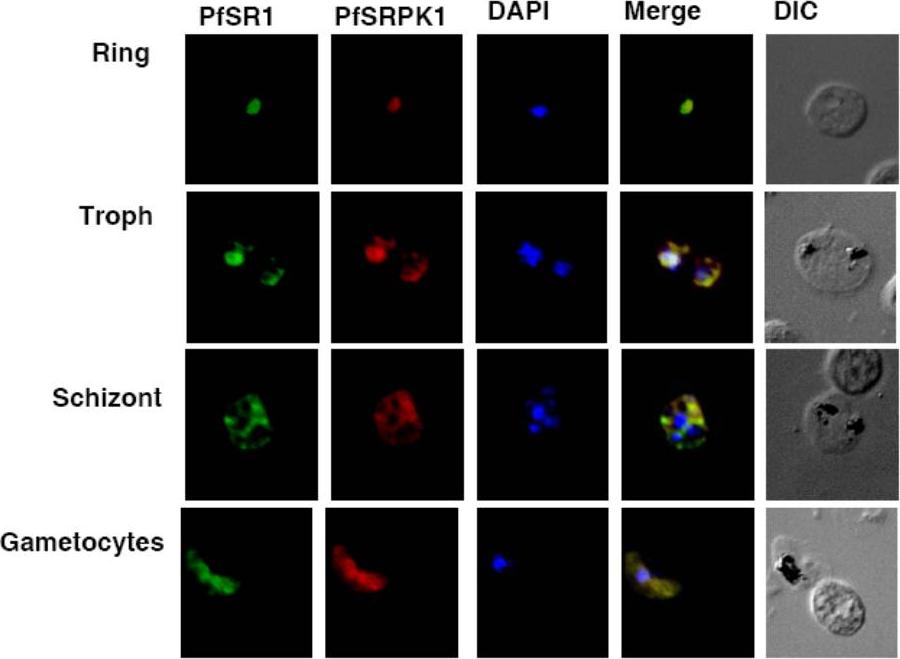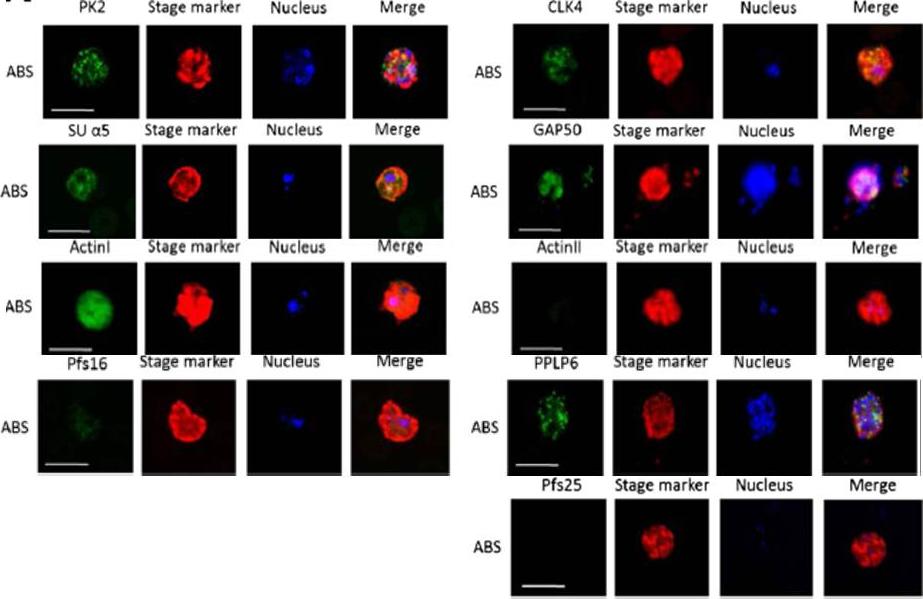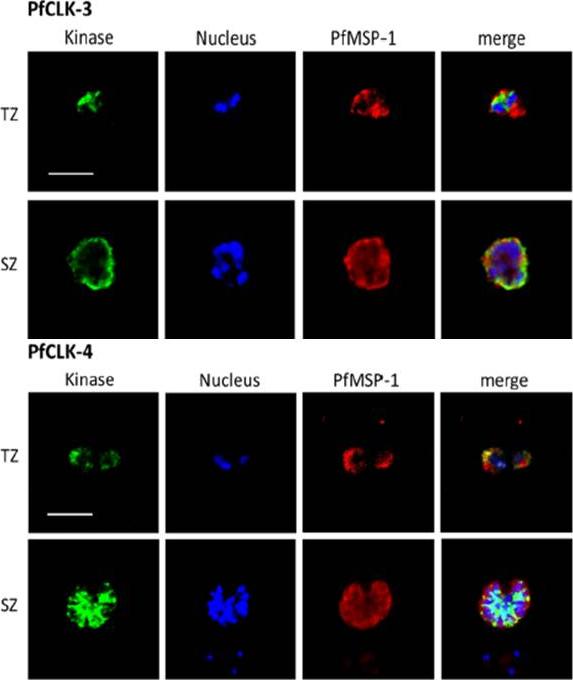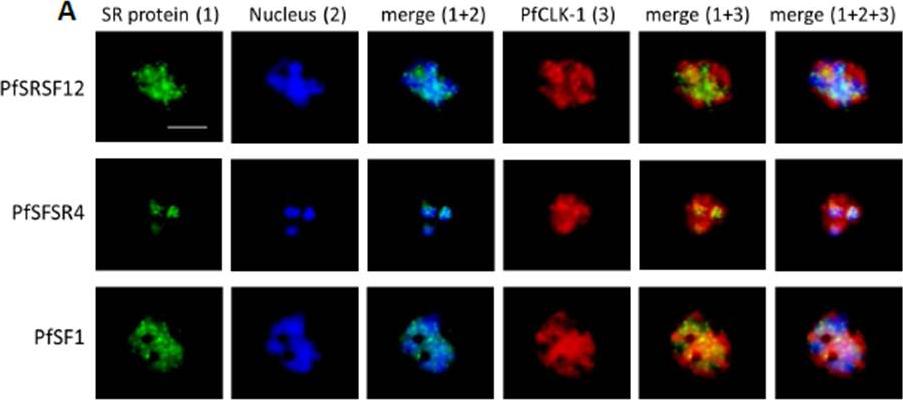PKNH_0840600 serine/threonine protein kinase, putative (SRPK1)
Disruptability [+]
| Species | Disruptability | Reference | Submitter | |
|---|---|---|---|---|
| P. berghei ANKA |
Possible |
RMgm-528 | Imported from RMgmDB | |
| P. berghei ANKA |
Possible |
PlasmoGEM (Barseq) | PlasmoGEM | |
| P. falciparum 3D7 |
Refractory |
22127061 | Theo Sanderson, Wellcome Trust Sanger Institute | |
| P. falciparum 3D7 |
Possible |
USF piggyBac screen (Insert. mut.) | USF PiggyBac Screen | |
| P. falciparum 3D7 |
Possible |
36094218 | Sudhir Kumar, Seattle Children\'s Research Institute, Seattle, Washington, USA | |
Mutant phenotypes [+]
| Species | Stage | Phenotype | Reference | Submitter |
|---|---|---|---|---|
| P. berghei ANKA | Asexual |
Difference from wild-type |
RMgm-528
mildly reduced growth |
Imported from RMgmDB |
| P. berghei ANKA | Asexual |
Attenuated |
PlasmoGEM (Barseq) | PlasmoGEM |
| P. falciparum 3D7 | Asexual |
Difference from wild-type |
36094218 | Sudhir Kumar, Seattle Children\'s Research Institute, Seattle, Washington, USA |
| P. berghei ANKA | Gametocyte |
Difference from wild-type |
RMgm-528
Male gametocytes do not exflagellate; female gametocyte produce fertile gametesas shown by fertilisation with by wild type male gametes (in vitro) |
Imported from RMgmDB |
| P. falciparum 3D7 | Gametocyte |
Difference from wild-type |
36094218 | Sudhir Kumar, Seattle Children\'s Research Institute, Seattle, Washington, USA |
| P. berghei ANKA | Ookinete |
Difference from wild-type |
RMgm-528
No ookinete formation. Male gametocytes do not exflagellate; female gametocyte produce fertile gametesas shown by fertilisation with by wild type male gametes (in vitro) |
Imported from RMgmDB |
| P. berghei ANKA | Oocyst |
Difference from wild-type |
RMgm-528
no oocysts |
Imported from RMgmDB |
| P. falciparum 3D7 | Oocyst |
Attenuated |
36094218 | Sudhir Kumar, Seattle Children\'s Research Institute, Seattle, Washington, USA |
Imaging data (from Malaria Metabolic Pathways)

Immunofluorescence studies performed on blood smears made from cultures containing parasites of different stages using antisera against PfSRPK1 (red), PfSR1 (green). Parasite nuclei were stained with DAPI. The staining for PfSR1 and PfSRPK1 overlapped in all parasitic stages These proteins were present predominantly inside the nucleus in the ring stages as indicated by co-localization with nuclear dye DAPI. PfSRPK1 and PfSR1 were present in the nucleus of ~75% of rings and young trophozoites that were analyzed. As the parasites matured, PfSRPK1 and PfSR1 seemed to be exported to nuclear periphery and/or cytoplasm in mature trophozoites. Both these proteins were predominantly in the cytoplasm of most (>80%) schizonts.Dixit A, Singh PK, Sharma GP, Malhotra P, Sharma P. PfSRPK1, a novel splicing-related kinase from Plasmodium falciparum. J Biol Chem. 2010 285(49):38315-23
See original on MMP
Immunofluorescence assays, using specific antibodies, detected the proteins of interest (in green) in asexual blood stage (ABS) parasites, using MSP1 (in red). Nuclei were highlighted by Hoechst nuclear stain (in blue). Bar, 5 μm. Ngwa CJ, Scheuermayer M, Mair GR, Kern S, Brügl T, Wirth CC, Aminake MN, Wiesner J, Fischer R, Vilcinskas A, Pradel G. Changes in the transcriptome of the malaria parasite Plasmodium falciparum during the initial phase of transmission from the human to the mosquito. BMC Genomics. 2013 Apr 15;14:256
See original on MMP
Subcellular localization of PfCLK-3 and PfCLK-4 in the blood stage. Mixed asexual blood stage cultures containing trophozoites (TZ) and schizonts (SZ) cultures were fixed with methanol and prepared for IFA, using rat antisera against PfCLK-3 and mouse antisera against PfCLK-4 (green). The parasite nuclei were highlighted by Hoechst staining (blue). The asexual blood stages were labelled with rabbit antisera against PfMSP-1. Bar, 5 mm. PfCLK-3 and PfCLK-4 are mainly present in the nucleus of trophozoites, while in schizonts and gametocytes both kinases are primarily located in the cytoplasm. Particularly for PfCLK-3 a rim-associated labelling pattern was observed in the latter stages. In the IFAs, the asexual blood stage parasites were highlighted by labelling of plasmalemma-associated proteins, i.e. PfMSP-1.Kern S, Agarwal S, Huber K, Gehring AP, Strödke B, Wirth CC, Brügl T, Abodo LO, Dandekar T, Doerig C, Fischer R, Tobin AB, Alam MM, Bracher F, Pradel G. Inhibition of the SR Protein-Phosphorylating CLK Kinases of Plasmodium falciparum Impairs Blood Stage Replication and Malaria Transmission. PLoS One. 2014 Sep 4;9(9):e105732.
See original on MMP
Co-localization and control IFAs. A. Immunolabelling of PfCLK-1 with rabbit antisera (red) detected the kinase in the schizonts´ cytoplasm as well as in the nuclei, where it co-localizes with the three SR proteins (green). Schizonts were counterlabelled with rabbit antibodies against PfMSP-1 (red). All nuclei were highlighted by Hoechst staining (blue). Bar, 5 μm. The co-localization experiments confirmed that the SR proteins are solely present in the nuclei, while in the early schizont stage, PfCLK-1 is present both in the parasite nuclei and the cytoplasm. Co-localization of PfCLK-1 with the three SR proteins can be detected in distinct nuclear regions. Kern S, Agarwal S, Huber K, Gehring AP, Strödke B, Wirth CC, Brügl T, Abodo LO, Dandekar T, Doerig C, Fischer R, Tobin AB, Alam MM, Bracher F, Pradel G. Inhibition of the SR Protein-Phosphorylating CLK Kinases of Plasmodium falciparum Impairs Blood Stage Replication and Malaria Transmission. PLoS One. 2014 Sep 4;9(9):e105732.
See original on MMPMore information
| PlasmoDB | PKNH_0840600 |
| GeneDB | PKNH_0840600 |
| Malaria Metabolic Pathways | Localisation images Pathways mapped to |
| Previous ID(s) | PK3_0030w, PKH_083770 |
| Orthologs | PBANKA_0401100 , PCHAS_0402000 , PF3D7_0302100 , PVP01_0837700 , PVX_119250 , PY17X_0403300 |
| Google Scholar | Search for all mentions of this gene |